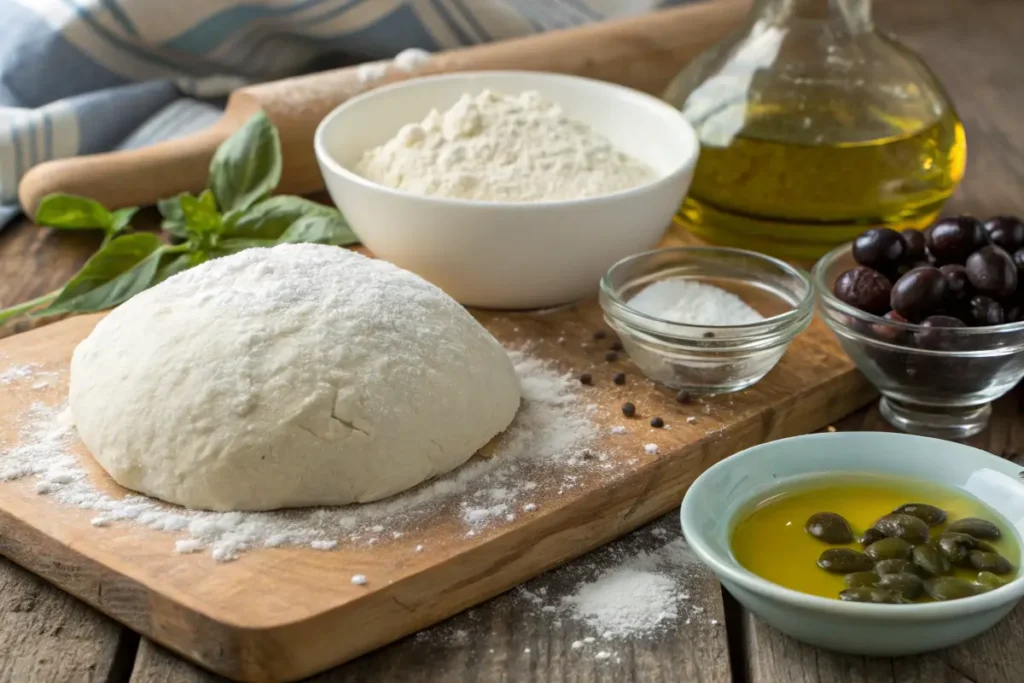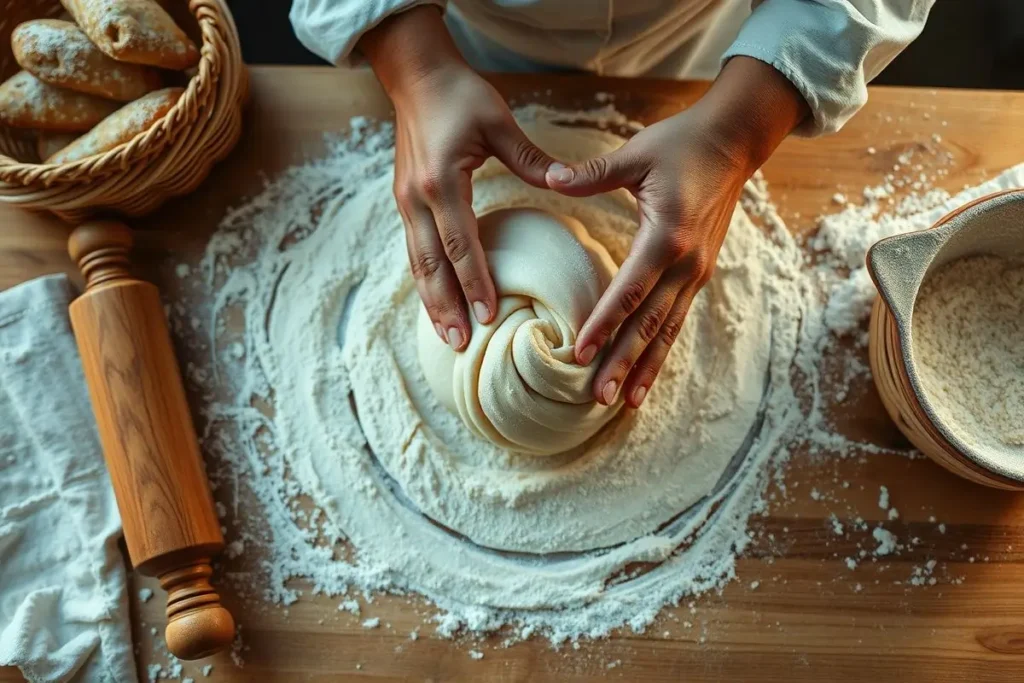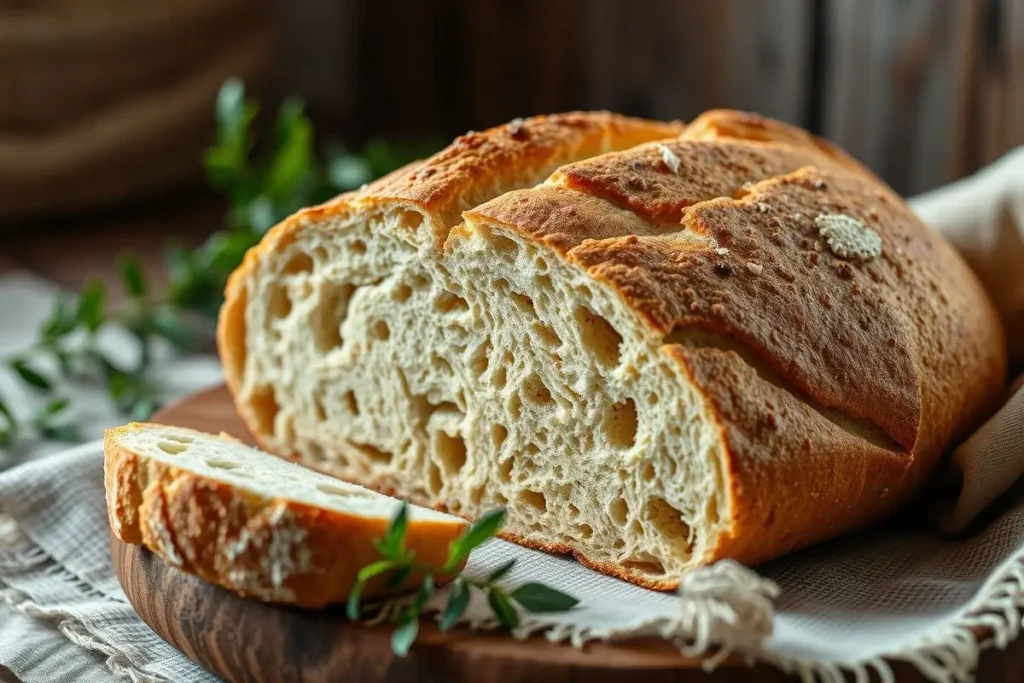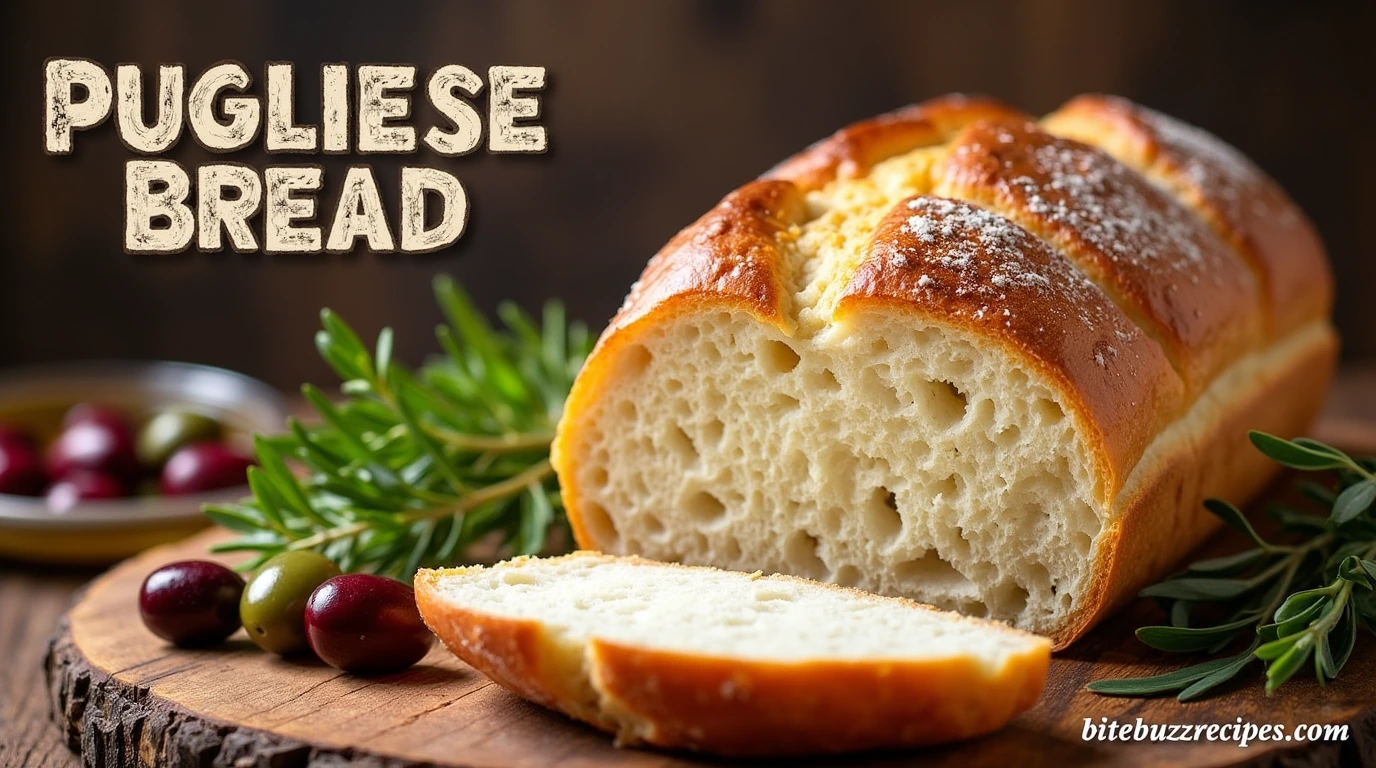In the sun-kissed region of Puglia, Italy, a traditional bread has been a staple in the local cuisine for centuries. This iconic Italian bread is known for its soft, airy interior and crispy, golden crust, making it a perfect accompaniment to a variety of dishes. With its rich history and cultural significance, Pugliese bread has become a beloved favorite among bread enthusiasts and Italian food lovers alike.
Whether you’re looking to try your hand at traditional Italian baking or simply want to indulge in the authentic flavors of Italy, learning how to make Pugliese bread at home can be a rewarding and delicious experience. In this article, we’ll delve into the world of Pugliese bread, exploring its origins, ingredients, and techniques, as well as providing tips and tricks for baking the perfect loaf in the comfort of your own kitchen.
Table of Contents
Introduction to Pugliese Bread
What is Pugliese Bread and its Origins
Imagine sinking your teeth into a crusty, fragrant loaf of Pugliese bread, fresh from the oven. This traditional Italian bread, hailing from the Puglia region, has been a staple for centuries. Known for its airy texture and mild flavor, it’s perfect for soaking up rich sauces or simply enjoyed on its own. If you’re passionate about Italian cuisine and looking for more delicious recipes, try making Oat Flour Pancakes: A Healthier Twist on a Classic Breakfast.
The history of this beloved bread is deeply rooted in Italian tradition, with its origins tracing back to the Middle Ages. Pugliese bread is traditionally crafted with type “00” flour, yeast, water, salt, and olive oil, each ingredient contributing to its distinctive taste and texture.
- Key characteristics of Pugliese bread include its crusty crust and soft interior.
- The bread is often shaped into a round or oblong form, with a dimpled surface.
- Flavor profiles of Pugliese bread can vary depending on the region and ingredients used, but it’s often described as mild and slightly sweet.
Brief History and Cultural Significance of Pugliese Bread in Italy
Immerse yourself in the rich flavors and traditions of Italy with Pugliese Bread, a culinary treasure that has been delighting palates for centuries. This iconic bread originates from the southern region of Puglia, where yeast fermentation and simple ingredients come together to create a truly authentic Italian experience.
Regional Specialties
The cultural significance of Pugliese Bread lies in its ability to bring people together, much like a warm, freshly baked loaf on a crisp morning. As you delve into the world of Italian cuisine, you’ll discover that each region has its unique specialties, from the crusty bread of Puglia to the delicate focaccia of Liguria.
Sensory Experience
The aroma of freshly baked Pugliese Bread is unmistakable, filling the air with the scent of warm bread and inviting all to gather around the table. As you take your first bite, the crunchy crust gives way to a soft, airy interior, releasing a burst of flavors that will leave you craving more. Whether you’re a seasoned bread enthusiast or just starting to explore the world of Italian cuisine, Pugliese Bread is sure to become a favorite, with its perfect balance of texture and flavor.
Why You Should Try Making Pugliese Bread at Home
Imagine the aroma of freshly baked bread filling your home, as the savory scent of crusty, traditional Italian bread fills the air. Making this type of bread at home is a rewarding experience, allowing you to control the ingredients and techniques. With just a few simple ingredients and basic kitchen equipment, you can create a delicious and authentic loaf that will impress your family and friends. For a perfect pairing, try our Asian Broccoli Recipe alongside your homemade bread.
To get started, you need to understand the essential components of this Italian classic, including high-quality flour, yeast, and water. Following a simple recipe and using the right techniques will ensure your homemade bread is as close to the original as possible.
Making bread at home requires patience and practice, but the end result—crispy on the outside and soft on the inside—is well worth the effort. This bread is perfect for serving with soups, stews, or salads. For creative ways to use it beyond meals, check out our Egg Pudding Powder: 5 Creative Ways to Use In Your Desserts for some unique ideas.
Key Details Of The Recipe
Time Requirements
| Category | Measurement |
|---|---|
| Prep Time | 30 minutes |
| Cooking Time | 35-40 minutes |
| Total Time | 1 hour 5 minutes |
Serving and Calorie Information
| Category | Measurement |
|---|---|
| Servings | 8-10 slices |
| Approximate Calories per Serving | 220-250 calories |
As you embark on making Pugliese Bread, it’s essential to consider the time and nutritional aspects of this recipe. With a relatively short preparation time and a cooking time that yields a perfectly crispy crust, you can enjoy this Italian bread in about an hour.
Understanding the Nutritional Value
When considering the servings and calories per serving, keep in mind that Pugliese Bread can be a satisfying accompaniment to various meals, from soups to salads. With approximately 220-250 calories per slice, it’s an excellent option for those seeking a hearty yet wholesome bread.
Ingredients and Equipment Needed

Main Components: Flour, Yeast, Water, Salt, and Olive Oil
Get ready to unleash the flavors of Italy as we dive into the world of Pugliese Bread, starting with its fundamental components. To create an authentic Pugliese Bread, you’ll need a combination of essential ingredients, including flour, yeast, water, salt, and olive oil.
| Ingredient | Measurement |
|---|---|
| Flour | 1 kg |
| Yeast | 10 g |
| Water | 650 ml |
| Salt | 20 g |
| Olive Oil | 20 ml |
These ingredients will form the foundation of your Pugliese Bread, providing the perfect balance of texture and flavor. For more information on creative ways to use ingredients, check out Alaskan Roll: A Delicious and Fresh Sushi Roll for inspiration on experimenting with different flavors.
Optional Toppings or Fillings: Herbs, Cheeses, and Meats
Elevate your Pugliese Bread to new heights by exploring the world of optional toppings and fillings. To add an extra layer of flavor and aroma, consider incorporating fresh herbs like rosemary or thyme into your Pugliese Bread. You can also experiment with different types of cheeses, such as parmesan or mozzarella, to create a rich and savory taste experience. For a heartier option, try adding meats like prosciutto or salami to give your Pugliese Bread a satisfying crunch. For more ideas on creative fillings, check out our recipe for Smoked Chicken Thighs, which can be used as a delicious filling for your Pugliese Bread.
Special Equipment: Stand Mixer, Wooden Spoon, and Baking Stone
Get ready to uncover the secret to creating an authentic Pugliese Bread, and it all starts with the right equipment. To make this Italian masterpiece, you’ll need a few essential tools, including a stand mixer, a wooden spoon, and a baking stone.
- A stand mixer will help you mix and knead the dough to the perfect consistency.
- A wooden spoon is ideal for scraping the sides of the bowl and folding the ingredients together.
- A baking stone will give your Pugliese Bread that crispy, crunchy crust that’s characteristic of this traditional Italian bread.
For more information on using the right equipment to achieve the perfect crust, check out this article on Raspberry Puree: Sweet, Smooth, and Perfect for Any Dessert, which highlights the importance of quality equipment in baking.
Special Considerations for Equipment
When choosing your equipment, consider the size of your Pugliese Bread and the space you have available in your kitchen.
- A larger stand mixer may be necessary for bigger batches of dough.
- A smaller wooden spoon may be more manageable for smaller batches.
Remember, the right equipment can make all the difference in creating an authentic Pugliese Bread that’s full of flavor and texture.
Substitutions and Variations: Gluten-Free, Vegan, and Low-Sodium Options
Get ready to elevate your Pugliese Bread game with innovative substitutions and variations that cater to diverse dietary needs. When making Pugliese Bread, consider using gluten-free flours like rice flour or almond flour to create a delicate crumb. For a vegan version, replace traditional yeast with natural yeast or experiment with plant-based milk. To reduce sodium content, use herbs and spices to add depth without the salt.
- Try using olive oil instead of butter for a lighter flavor
- Experiment with different types of flour to change the texture
For more creative variations, visit How To Make The Best Triple Chocolate Cake with These 5 Simple Steps for inspiration on working with diverse ingredients.
Preparation and Dough Formation

Step-by-Step Guide to Mixing and Kneading the Dough
Get ready to unleash your inner baker as we dive into the art of crafting the perfect Pugliese Bread dough. To start, combine 1 cup of warm water, 2 teaspoons of active dry yeast, and 1 tablespoon of olive oil in a large mixing bowl.
- Mix the ingredients together until the yeast is fully dissolved.
- Add 3 cups of all-purpose flour, 1 teaspoon of salt, and mix until a shaggy dough forms.
For more information on baking, check out 4 Ingredient Peanut Butter Cookies: Simple and Irresistible for a sweet treat to pair with your freshly baked Pugliese Bread.
Kneading the dough is a crucial step in developing the gluten and achieving the perfect texture.
- Use a stand mixer with a dough hook attachment
- Knead for 10 minutes until the dough becomes smooth and elastic.
Understanding Yeast Fermentation and Rising Time
As you embark on the journey of making Pugliese bread, the magic of yeast fermentation and rising time will leave you in awe. To create this delicious Italian staple, it’s essential to grasp the concept of yeast fermentation, which involves the tiny microorganisms feeding on sugars and producing carbon dioxide gas bubbles, causing the dough to rise. Here are the key steps involved in the process:
- Activating the yeast by mixing it with warm water and sugar
- Allowing the dough to rest and rise in a warm, draft-free environment
- Monitoring the rising time to ensure the dough has doubled in size
Shaping the Dough: Techniques for Creating the Perfect Crust
As you delicately shape the Pugliese bread dough, the aroma of yeast and flour fills the air, teasing your senses and building anticipation for the perfectly crusty loaf. To achieve this, follow these key steps:
- Gently deflate the dough to release any air bubbles.
- Shape the dough into a round or oblong form, depending on your preference.
- Use your hands to create a smooth, even surface, applying gentle pressure to eliminate any wrinkles.
For a more rustic crust, try using a banneton or a wicker basket to shape the dough. You can also find inspiration for other creative bread shapes on websites like Sushi Pizza: A Fun and Delicious Fusion of Sushi and Pizza, which showcases unique flavor combinations and presentation ideas.
Shaping the dough is an art that requires patience and practice, but with time and experience, you’ll master the technique for creating the perfect Pugliese bread crust.
Tips for Achieving the Right Dough Consistency and Texture
As you embark on the journey to create the perfect Pugliese Bread, you’ll soon discover that achieving the right dough consistency and texture is an art that requires patience, practice, and a deep understanding of the intricacies involved. To get started, it’s essential to understand the role of yeast fermentation and how it affects the final product.
- Begin by mixing the ingredients with a stand mixer or a wooden spoon, ensuring that the dough comes together in a cohesive mass.
- Next, knead the dough for approximately 10 minutes, until it becomes smooth and elastic.
- Use a dough scraper to scrape the sides of the bowl and incorporate any remaining flour.
- Apply gentle pressure to avoid overworking the dough.
For more information on working with yeast, consider exploring recipes like Supreme Pizza, which also rely on the complexities of yeast fermentation to achieve the perfect crust.
Achieving the Perfect Crust
To achieve the perfect crust on your Pugliese Bread, it’s crucial to understand the importance of crust formation and how it’s affected by factors like temperature, humidity, and baking time.
- Monitor the temperature of your oven to ensure it’s at the optimal level.
- Keep an eye on the bread’s progress, checking for the characteristic golden-brown color and crispy texture.
For a deeper dive into the world of crust formation, you can explore resources like Almond Flour Tortillas, which offer a unique perspective on working with alternative flours and achieving the perfect texture.
Remember, practice makes perfect, so don’t be discouraged if your first attempts at creating Pugliese Bread don’t yield the desired results. With time and patience, you’ll develop the skills and intuition necessary to craft a truly exceptional loaf.
Baking and Cooling Pugliese Bread
Preheating the Oven and Preparing the Baking Stone
As you embark on the journey to create the perfect Pugliese Bread, the moment of truth arrives: preheating the oven. To achieve that crispy crust and airy interior, it’s essential to preheat your oven to the right temperature.
- Set your oven to 425°F (220°C) with the baking stone inside.
- Allow the oven to preheat for at least 30 minutes to ensure the stone reaches the optimal temperature.
Tips for Preheating
- Preheat your oven with the baking stone inside to absorb moisture and ensure a crisp crust.
- Use a thermometer to verify the oven temperature for accurate results.
Baking the Bread: Temperature, Time, and Crust Formation
As the aroma of freshly baked Pugliese bread wafts through the air, it’s time to delve into the crucial step of baking. To achieve a perfectly crusty Pugliese bread, follow these steps:
- Preheat the oven to 425°F (220°C) with a baking stone inside.
- Place the shaped dough on the preheated stone.
- Bake for 25-30 minutes, or until the crust is golden brown and sounds hollow when tapped.
For more information on achieving the perfect crust, check out this article on Italian Stuffed Peppers, which also explores the importance of crust formation in Italian baking. By mastering this technique, you’ll be able to create a delicious Pugliese bread with a crispy crust and a soft interior.
Cooling and Storing the Bread: Maintaining Freshness and Texture
As you take your freshly baked Pugliese bread out of the oven, the aroma of warm bread wafts through the air, tempting your taste buds. To maintain the freshness and texture of your Pugliese bread, it’s essential to cool and store it properly.
- Allow the bread to cool on a wire rack for at least 30 minutes before storing.
- Store the bread in an airtight container at room temperature for up to 3 days.
For more information on storing bread, you can check out our article on 3 Ingredient BBQ Sauce: Quick and Easy to Make, which also discusses the importance of proper food storage.
Cooling and Storing Tips
- Store in a cool, dry place
- Avoid direct sunlight
You can also explore other baking ideas, such as using Egg Pudding Powder: 5 Creative Ways to Use In Your Desserts to make delicious desserts.
Troubleshooting Common Issues: Overcooking, Undercooking, and Crust Problems
As you carefully craft your Pugliese Bread, beware of the pitfalls that can transformed a perfectly good loaf into a culinary disaster. To avoid overcooking, undercooking, or crust problems, follow these simple steps:
- Check the internal temperature of the bread to ensure it reaches 200°F – 210°F.
- Use a thermometer to verify the temperature, and adjust the baking time accordingly.
- Monitor the crust color, aiming for a golden brown hue.
- Rotate the bread halfway through the baking time to achieve an even crust.
By mastering these techniques, you’ll be well on your way to creating delicious Pugliese Bread that’s sure to impress.
Serving and Enjoying Pugliese Bread

Traditional Italian Ways to Serve Pugliese Bread: With Olive Oil, Herbs, and Cheeses
Imagine sinking your teeth into a freshly baked Pugliese bread, filled with the aroma of olive oil, fragrant herbs, and creamy cheeses. This classic Italian combination is a match made in heaven, and it’s the perfect way to enjoy your homemade Pugliese bread. To create this delicious pairing, simply drizzle extra virgin olive oil over your bread, sprinkle with fresh rosemary or thyme, and top with shaved parmesan cheese.
Simple yet Delicious
The key to this traditional Italian combination is to keep it simple. Focus on using high-quality ingredients, such as extra virgin olive oil, fresh herbs, and aged cheeses, to bring out the best flavors in your Pugliese bread. With these basic ingredients, you can create a variety of delicious combinations to suit your taste. Whether you’re looking for a quick snack or a side dish to accompany your favorite Italian meal, Pugliese bread with olive oil, herbs, and cheeses is the perfect choice.
Creative Ways to Use Pugliese Bread: Sandwiches, Paninis, and Croutons
Imagine sinking your teeth into a crunchy Pugliese Bread sandwich, filled with freshly sliced meats, cheeses, and herbs. The crust gives way to a soft, airy interior, infused with the aroma of yeast and olive oil. To create such delights, follow these simple steps:
- Slice the Pugliese Bread into thick rounds or cubes.
- Fill with your favorite ingredients, such as turkey, avocado, or tomato.
- Top with a drizzle of olive oil and a sprinkle of salt.
Some ideas for Pugliese Bread creations include:
- Grilled paninis with melted mozzarella and fresh basil
- Croutons tossed in herbs and spices for a savory snack
- Cubed Pugliese Bread toasted with garlic and olive oil for a satisfying side dish
For more inspiration, check out our recipe for cavatelli and broccoli, which pairs perfectly with a slice of freshly baked Pugliese Bread. Alternatively, explore the world of desserts with Egg Pudding Powder: 5 Creative Ways to Use In Your Desserts.
Pairing Pugliese Bread with Other Italian Dishes: Pastas, Soups, and Salads
As you slice into a warm, crusty loaf of Pugliese Bread, the aroma of freshly baked bread fills the air, teasing your senses and tempting you to explore the world of Italian cuisine. Pugliese Bread is a versatile companion to many Italian dishes, from rich olive oil-based pasta sauces to hearty minestrone soups. To get the most out of your Pugliese Bread, try pairing it with:
- A simple caprese salad, featuring fresh mozzarella, tomatoes, and basil
- A warm, comforting bowl of Italian wedding soup, filled with meatballs and escarole
- A rich and satisfying pasta alla carbonara, tossed with spaghetti, bacon, and parmesan cheese
For more inspiration, check out our recipe for Honey Mustard Pretzels: The 3 Secrets to Making the Best Ones at Home, and discover how the perfect snack can elevate your Italian dining experience. Whether you’re in the mood for something classic and comforting or new and adventurous, Pugliese Bread is the perfect companion for your Italian culinary journey.
Tips for Freezing and Reheating Pugliese Bread for Future Meals
Imagine sinking your teeth into a warm, crusty loaf of Pugliese bread, fresh from the oven. To make this a reality even on busy days, consider freezing your Pugliese bread for later. When freezing, it’s essential to cool the bread completely to prevent moisture from forming ice crystals.
- Wrap the cooled bread tightly in plastic wrap or aluminum foil.
- Place the wrapped bread in a freezer-safe bag, squeezing out as much air as possible.
To reheat, simply thaw the bread overnight at room temperature or reheat it in the oven at 350°F (175°C) for about 10-15 minutes, until it’s warmed through and the crust is crispy again. For an extra burst of flavor, try serving your reheated Pugliese bread with a drizzle of Hot Honey Sauce, adding a sweet and spicy kick to your meal.
Wrapping Up: Why Pugliese Bread Should Be Your Next Baking Adventure
In conclusion, Pugliese Bread is more than just a loaf; it’s a slice of Italian tradition that brings an irresistible flavor and texture to any meal. The unique blend of ingredients and the traditional methods used to make Pugliese Bread create a rustic, crusty bread that stands out from other types of bread. Whether you’re an experienced baker or just starting out, making Pugliese Bread at home is a rewarding experience that will fill your kitchen with the aroma of Italy.
If you’re looking to add a new bread recipe to your collection, Pugliese Bread is the perfect choice. With its chewy interior and crispy crust, it’s ideal for pairing with a variety of dishes, from soups to cheese platters, or simply enjoyed on its own with a drizzle of olive oil. Not only does it add a touch of authenticity to your meals, but the process of baking Pugliese Bread also gives you a deeper appreciation for the art of bread-making.
So, whether you’re crafting your first batch or perfecting your skills, remember that baking Pugliese Bread is not just about following a recipe—it’s about embracing a piece of Italian heritage. Try it out today, and soon you’ll have a delicious loaf of Pugliese Bread ready to be enjoyed by friends and family.


1 thought on “Pugliese Bread Recipe: 5 Tips for Baking the Best Italian Bread at Home”